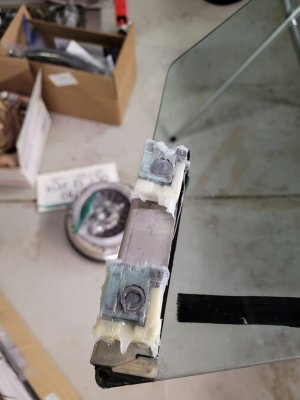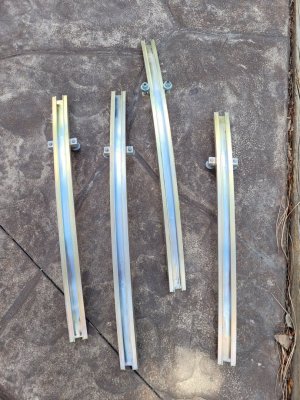As I get ready to clean and re-grease my window rails, I've started to really study the lubrication side of it. The most extreme example is at T3TEC in Japan, where they subject new rails to some kind of PTFE or other hard lubricant treatment prior to greasing (called a "Tough Ram" treatment). This results in apparently a very long lasting rail system.
http://t3tec.jp/product
The traditional advice here on Prime has been to stick to the tried-and-true solution of the Honda Urea grease, with the understanding that it is a long-lasting grease with good moisture resistance. In other words, perfect for the window rails inside the doors. However, we also know that the urea grease dries out after about 5-7 years and the leftover carrier turns into this gummy, sticky mess that not only slows the windows down, but also must be 100% cleaned off of the rails before re-greasing, requiring removal of the rails from the doors, which then requires the awful window-alignment service to be performed. Lubrication technology has come a long way since 1989 and I've been thinking about possible alternatives that would eliminate the need to open our doors every 5 years and suffer through the miserable window alignment procedure. Basically, we need a grease with the following characteristics:
I've found 3 possible solutions and would like the community's input:
1. SuperLube Synthetic Grease with Syncolon (PTFE) - https://www.super-lube.com/multi-purpose-synthetic-grease-with-syncolon-ptfe
This grease appears to be a full synthetic carrier impregnated with PTFE powder. It is specifically described as "...does not evaporate or form gummy deposits. It will not melt or separate." The operating temperature range is impressive: -45 F to 450 F, much more than our window rails will ever see. Still, is has a petroleum-based carrier and I suppose there is a chance that it could still dry out on the rails. Though, it would leave PTFE behind, which should still provide some lubrication better than the urea grease.
2. SuperLube Silicone Lubricating Grease with Syncolon (PTFE) - https://www.super-lube.com/silicone-lubricating-grease-with-syncolon-ptfe
This stuff takes the petroleum carrier out of the equation completely and replaces it with silicone, which in theory should last forever. However, the lubricity of the silicone is probably much less than a true petroleum-based grease, so the windows might not operate as quickly. However, this also has PTFE and, being silicone, has excellent water-resistance. I suspect if I put it in the rails, it would stay there forever.
3. Permatex Anti-Seize Lubricant - https://www.permatex.com/products/lubricants/specialty-lubricants-anti-seize/permatex-anti-seize-lubricant-2/
This is kind of an outside-the-box idea, but it could work. This anti-sieze relies on three hard-lubricants (aluminum, copper and graphite) to provide long-term coverage. But, the carrier is a parrafin/petroleum-based grease, so there is a chance it could dry out and gunk up like the urea grease.
Finally, I've noticed that [MENTION=25737]Kaz-kzukNA1[/MENTION] and most of the Japan-based NSX specialists use a urea grease that is very dark gray in color versus the greenish version here in the states. I strongly suspect this JDM urea is impregnated with graphite and/or moly, since it closely resembles the Aeroshell moly grease I use on my AR-15 rifles. Also, if you've ever looked at the factory-original grease on the NSX, it's this gray stuff- not the green grease. Curious about folks' thoughts on the above, since I'd love not to have to re-grease my windows again.
http://t3tec.jp/product
The traditional advice here on Prime has been to stick to the tried-and-true solution of the Honda Urea grease, with the understanding that it is a long-lasting grease with good moisture resistance. In other words, perfect for the window rails inside the doors. However, we also know that the urea grease dries out after about 5-7 years and the leftover carrier turns into this gummy, sticky mess that not only slows the windows down, but also must be 100% cleaned off of the rails before re-greasing, requiring removal of the rails from the doors, which then requires the awful window-alignment service to be performed. Lubrication technology has come a long way since 1989 and I've been thinking about possible alternatives that would eliminate the need to open our doors every 5 years and suffer through the miserable window alignment procedure. Basically, we need a grease with the following characteristics:
- wide temperature range
- good moisture resistance
- good "wet" lubrication properties
- leaves no sticky/gummy mess when aged/dried out
- leaves behind lubricating materials as it dries out (PTFE/graphite)
I've found 3 possible solutions and would like the community's input:
1. SuperLube Synthetic Grease with Syncolon (PTFE) - https://www.super-lube.com/multi-purpose-synthetic-grease-with-syncolon-ptfe
This grease appears to be a full synthetic carrier impregnated with PTFE powder. It is specifically described as "...does not evaporate or form gummy deposits. It will not melt or separate." The operating temperature range is impressive: -45 F to 450 F, much more than our window rails will ever see. Still, is has a petroleum-based carrier and I suppose there is a chance that it could still dry out on the rails. Though, it would leave PTFE behind, which should still provide some lubrication better than the urea grease.
2. SuperLube Silicone Lubricating Grease with Syncolon (PTFE) - https://www.super-lube.com/silicone-lubricating-grease-with-syncolon-ptfe
This stuff takes the petroleum carrier out of the equation completely and replaces it with silicone, which in theory should last forever. However, the lubricity of the silicone is probably much less than a true petroleum-based grease, so the windows might not operate as quickly. However, this also has PTFE and, being silicone, has excellent water-resistance. I suspect if I put it in the rails, it would stay there forever.
3. Permatex Anti-Seize Lubricant - https://www.permatex.com/products/lubricants/specialty-lubricants-anti-seize/permatex-anti-seize-lubricant-2/
This is kind of an outside-the-box idea, but it could work. This anti-sieze relies on three hard-lubricants (aluminum, copper and graphite) to provide long-term coverage. But, the carrier is a parrafin/petroleum-based grease, so there is a chance it could dry out and gunk up like the urea grease.
Finally, I've noticed that [MENTION=25737]Kaz-kzukNA1[/MENTION] and most of the Japan-based NSX specialists use a urea grease that is very dark gray in color versus the greenish version here in the states. I strongly suspect this JDM urea is impregnated with graphite and/or moly, since it closely resembles the Aeroshell moly grease I use on my AR-15 rifles. Also, if you've ever looked at the factory-original grease on the NSX, it's this gray stuff- not the green grease. Curious about folks' thoughts on the above, since I'd love not to have to re-grease my windows again.











